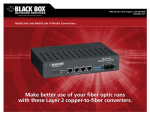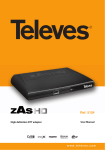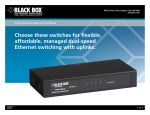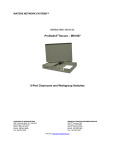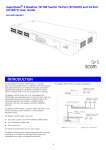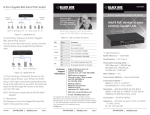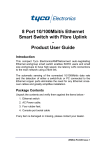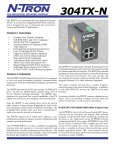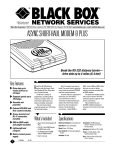Download MANAGED EXPRESS SWITCHES
Transcript
MANAGED EXPRESS SWITCHES Ethernet and Fast Ethernet autonegotiation plus the distance of fiber! Key Features Seven 10/100 ports and one 100BASE-FX multior single-mode fiber port. Fiber distances up to 2 or 15 km (1.2 or 9.3 mi). Manage through console, Web browser, telnet, or SNMP. IGMP multicast snooping support. 802.1Q tagged VLAN support. 802.1p Priority Queuing/Class of Service (CoS) support. True non-blocking switch architecture. ombine Ethernet and Fast Ethernet autonegotiation with the distance of a fiber connection with a BLACK BOX Managed Express Switch. It offers you an affordable way to interconnect workgroups in a community, campus or industrial environment, or any multi-tenant location that covers a large area. This versatile switch, which can be managed via its console interface, a standard Web browser, or SNMP, comes with seven RJ-45 ports for 10-Mbps Ethernet or 100-Mbps Ethernet connections as well as one 100Mbps fiber optic port (multimode or single-mode). Because the fiber signal is made of light, very little signal loss occurs during transmission, so data can move at greater distances. For fiber connections up to 2 km (1.2 mi.), order the LB9030A or LB9031A with their multimode SC or ST port. If you want even longer distances—up to 15 km (9.3 mi.) over single-mode SC fiber—order our LB9032A. C ® ® Document Number 26080 Using a fiber link also gives you greater security and immunity from interference with no crosstalk (NEXT) and electromagnetic interference (EMI) problems. With switching speeds up to 148,800 pps on all Fast Ethernet ports, the Managed Express Switch provides forwarding rates at wire speed. The switch also has true non-blocking switch architecture, so it can process various packets at the same time. You’re also given IGMP snooping capabilities, so traffic only reaches the groups of users you want it to. Want to set priorities on traffic flow? 802.1p Priority Queuing Class of Service (CoS) capabilities enable you to do just that. With its support for port-based VLANs and 802.1Q tagged VLANs, the switch can be used to alter the Ethernet frames so you can segment end users in separate LANs. This way, you can improve your traffic management and your network security. IP multicast filtering enables the switches to support IP multicast traffic and video multicasting or broadcasting. Installation and operation involves simply plugging in your cabling and connecting power. Designed for use in the office or wiring closet, the Managed Express Switch can be used as a standalone unit, wallmounted, or rackmounted. Ethernet and Fast Ethernet ports The Managed Express Switch features 10BASE-T and 10BASET/100BASE-TX ports, which use RJ-45 connectors. You can operate the switches in several modes: • 10BASE-T full-duplex mode, • 10BASE-T half-duplex mode, • 100BASE-TX full-duplex mode, • 100BASE-TX half-duplex mode, or • Autosensing mode. Half-duplex mode uses back pressure flow control to prevent the receiving buffer from being Page 1 of 3 (continued from page 1) overrun by data from a source node, whereas full-duplex mode uses the 802.3X flow control standard to prevent fast data traffic from overrunning your slow data traffic. In autosensing mode, the switch autonegotiates with the other end of your link, determines whether full-duplex or half-duplex mode is required, and adjusts itself automatically. When configured for 10BASET operation, the switch’s ports are ideal for connecting single endstations, 10BASE-T hubs, or any 10BASE-T-compatible device that uses standard 10BASE-T adapters and wiring. 10BASE-T ports, configured as MDIX, provide full 10-Mbps bandwidth to attached devices and offer you a maximum segment length of 100 m (328 ft.) over Category 3, 4, or 5 twisted-pair cable. To connect to a server or network backbone, the Managed Express Switch can be configured for 100BASE-TX operation. The 100BASE-TX ports give you 100Mbps bandwidth to attached devices and, like the 10BASE-T ports, are configured as MDIX. The maximum segment length for 100BASE-TX operation is 100 m (328 ft.) over Category 5 twisted-pair cable. Managing the switch You can access and manage the Managed Express Switch via an administration console or any Web browser interface, both of which are embedded in the switch’s software, or through an external SNMP-based network management application. In addition to SNMP, the switch supports virtual terminal protocols, such as Telnet, which enable you to establish a management session across a network from a PC, Mac , or UNIX workstation. ® ® Console management By using the text-based administration console management method, you don‘t need an IP address or subnet— and it’s secure. The console, which is a character-oriented, menu-driven user interface, Document Number 26080 enables you to display statistics and change your switch‘s option settings from a terminal, PC, Mac, or workstation connected to the switch’s console serial port. This can be done by connecting a terminal or computer with a terminal emulation program or by attaching an external modem. Through the console interface’s management screen, you can change the system name, location and administration along with guest passwords, statistics collection, reboot-on-error, and remote Telnet login capabilities. You can also configure the line speed, flow control, link type, and physical address of a LAN port. For the console port, you can change its baud rate, flow control method, modem control, and setup string as well as enable/disable SLIP and configure the SLIP address and SLIP subnet. The switch’s administration console also features Advanced Management screen, which you use to set up VLANs, to change the switch’s MAC addresses, IP networking, bridging, static filtering, Spanning Tree, port trunking, port mirroring, and to upgrade software. Within this screen, you can also view the switch from different perspectives so you can manage and monitor VLANs and their associated MAC addresses and ports effectively. See the device from the VLAN, IP multicast group, MAC address, or port perspective. The console’s Advanced Management screen also has an area from which you can view or change IP and RIP settings; add, delete, and search ARP table entries; specify DHCP gateway settings; and view or change ping settings. And, in yet another screen, you can configure protocol settings for SNMP, GVRP, and IGMP. Browser management The Web browser route is ideal for managing the switch remotely. Access the device’s Web interface applications directly in your Web browser by entering an IP address that you assign for the switch. Then use the browser to list and manage your configuration parameters from one central location, just as if you were connected to the switch‘s console port directly. This route, however, requires that you have either Microsoft Internet Explorer 4.01 or later or Netscape Navigator 4.03 or later. Point-and-click menus within the switch’s browser interface simplify your management tasks. Use a File menu to to save settings in the browser, download software upgrades via TFTP, and reboot the switch. The system’s Basic Setup menu includes management for LAN port and console port activities. As with the console route, the browser interface includes additional menus for setting up more advanced functions. Use these to manage MAC addresses as well as IP networking, per-port statistics, static MAC filters, SNMP, port trunking, and port mirroring. You can also use the browser to receive files via TFTP. Basic Setup menu functions within the browser include general options for changing a system or location name, statistics collection, reboot-onerror, and remote Telnet login capability. You can also configure speed and flow control for the LAN port, and view the speed and flow control for all switch ports from a single screen. Within the same Basic Setup menu you can configure the console port, too. Change the console‘s baud rate, method of flow control, modem control, and setup string in the menu, which also lets you enable and disable SLIP and configure the SLIP address and SLIP subnet mask. Use the browser interface’s Advance Setup screen to manage MAC addresses and access IP and RIP settings, ARP table parameters, the default gateway, and DHCP gateway settings. It also enables you to view statistical data of selected ports on the switch, set port priority, and mirror one port to another as well as alter Spanning Tree configurations and port settings. SNMP, GVRP, and IGMP settings ® ® can also be changed within the browser-based Advanced Setup screen. SNMP management If you use the switch with SNMP manager software, you can communicate with the switch functions at the MIB level. The standard management protocol for multivendor IP networks, SNMP supports transactionbased queries that enable the protocol to format messages and to transmit information between reporting devices and datacollection programs. SNMP is particularly useful in mission-critical applications. With just two basic network commands, management programs can control entire enterprise-wide networks precisely. SNMP manages network configuration, performance, faults, accounting, and security. It’s possible to both pinpoint and troubleshoot system problems or perform remote configuration from any SNMP management workstation anywhere in your network using just two simple commands: Get and Set. You’re also given RMON capabilities with the switch. RMON, an extension of SNMP, provides central-site management for distributed LANs. RMON gathers Physical Layer (OSI Layer 1) network information from nine Management Information Bases (MIBs), in contrast with SNMP, which supports only one. Use the Managed Express Switch’s RMON functions to set network parameters and view statistical counters defined in MIB-II, Bridge MIB, and RMON MIB at a network management station that‘s running a SNMP application with a GUI. Specifically, the switch supports four RMON MIB groups defined in RFC1757: RMON statistics, history, alarm, and event groups. It also supports four Bridge MIB groups (dot1dBase, dot1dStp, dot1dTp, and dot1dStatic). Page 2 of 3 Specifications definable port priority; four queues per output port; packet transmission scheduled using Weighted Round Robin (WRR); user-defined weights Compliance: FCC Part 15 Class A; CE; VCCI Class B Protocols: Bridging: 802.1D Spanning Tree; 802.1P/Q GARP/GVRP; Routing: RIP, RIP-2, DHCP-Relay; ICMP Router Discovery Message; IP multicast: IGMP snooping; IP multicast packet filtering (with a maximum of 128 VLANs and IP multicast sessions) Filtering: Packet filtering of source and destination MAC addresses Forwarding Rate: 10 Mbps: 14,880 pps; 100 Mbps: 148,800 pps Flow Control: Full-duplex (802.3X) and half-duplex (back pressure) MAC Addresses: Supports 1024 entries with address filtering on all ports; 2K internal cache on the chip and a 14K external table on SRAM sharing the packet buffer memory Standards: 100BASE-TX, 100BASE-FX: IEEE 802.3u; 10BASE-T: IEEE 802.3 Distance (Maximum): RJ-45 ports: 100 m (328 ft.); Multimode fiber port: 2 km (1.2 mi.); Single-mode fiber port: 15 km (9.3 mi.) Network Management: (1) RS-232 port as local control console; Telnet remote control console; SNMP agent: MIB-2 (RFC1213), bridge MIB (RFC1493), RMON MIB (RFC1757), VLAN MIB (802.1Q/RFC2674), private MIB; Java applet-based MIB browser; Class of Service (CoS): Classification of packet priority can be based on either a VLAN tag on packet, or a user- Web browser support based on HTTP server and CGI parser; TFTP/Kermit software upgrade capability Port Security: Limits number of MAC addresses learned per port; static MAC addresses remain in the filtering table Port Trunking: Link aggregation supports (4) groups total with a maximum of (8) ports per group; load sharing based on source and destination MAC addresses Processor: Switch manager CPU: 50-MHz Motorola MPC-850 embedded processor ® Speed: RJ-45 ports: 10 or 100 Mbps, autonegotiating, half- or full-duplex; Fiber port: 100 Mbps, full-duplex Connectors: (7) 10BASE-T/100BASE-TX autosensing (RJ-45); (1) 100BASE-FX (SC or ST) multimode or single-mode Indicators: (1) LED for power; Per RJ-45 port: (6) LEDs for 100-Mbps speed, collision, half- or full-duplex, link activity, RX, TC Operating Environment: Temperature: 32 to 104°F (0 to 40°C); Humidity: 10 to 90% noncondensing Power: 100–120 VAC, 50–60 Hz, external Size: 1.4"H x 8"W x 5.3"D (3.6 x 20.3 x 13.5 cm) Weight: 3.5 lb. (1.6 kg) System Memory: 4–16-MB DRAM; 512-KB–1-MB flash ROM Switching Method: Store and forward Ordering Information Package includes: • Managed Express Switch • AC power cord • User manual ITEM CODE Managed Express Switches with (7) 10-/100-Mbps RJ-45 Ports and (1) 100-Mbps Fiber Optic Port SC (2 km)..............................................................LB9030A ST (2 km).............................................................LB9031A SC (15 km)............................................................LB9032A You may also need… CAT5 Patch Cable, 100-MHz, 4-Pair, Straight-Pinned, PVC, Beige, 10-ft. (3-m) ...........................EMMSL05-0010 ® Black Box offers the best warranty program in the industry—Fido Protection . For more information, request FaxBack 22512. ® Document Number 26080 Page 3 of 3




